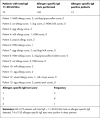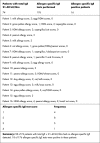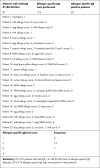The predictive value of total serum IgE for a positive allergen specific IgE result
- PMID: 15333657
- PMCID: PMC1770430
- DOI: 10.1136/jcp.2004.017681
The predictive value of total serum IgE for a positive allergen specific IgE result
Abstract
Background: Measurement of total serum IgE and allergen specific IgE is often requested to assess possible allergy. As public awareness increases, so do requests for allergy assessment; unless there is a clear "allergen suspect" in the history, several allergen specific IgE requests may be made. This increases the likelihood of detecting borderline increases in allergen specific IgE of uncertain relevance, and has important cost implications for the service.
Aims: To provide an evidence base for this observation.
Methods: In this retrospective observational study, results from 301 patients under 16 years of age from whom blood was taken for "allergy testing" from March 2001 to February 2003 were studied.
Results: Allergen specific IgE testing in children with low total serum IgE concentrations (<10 IU/litre) yielded very few positive results (three of 73 children), except in those being investigated for an acute reaction to a single food; when IgE was 11-20 kU/litre, 13 of 73 children had positive allergen specific IgE; in the 21-40 kU/litre IgE group, 16 of 74 children had positive allergen specific IgE and in the 41-80 kU/litre group, 22 of 81 had positive allergen specific IgE.
Conclusions: Allergen specific IgE testing in children with low IgE concentrations (<10 kU/litre) produces few positive results in patients with non-specific symptoms. Laboratories should perform allergy testing for specific allergens regardless of total IgE concentration only when there are convincing clinical reasons to do so, and should not proceed with this if the total IgE is <10 kU/litre and the presenting symptoms are non-specific.
Figures




Similar articles
-
The predictive value of specific immunoglobulin E levels in serum for the outcome of oral food challenges.Clin Exp Allergy. 2005 Mar;35(3):268-73. doi: 10.1111/j.1365-2222.2005.02150.x. Clin Exp Allergy. 2005. PMID: 15784102
-
Accuracy of ImmunoCAP Rapid in the diagnosis of allergic sensitization in children between 1 and 14 years with recurrent wheezing: the IReNE study.Pediatr Allergy Immunol. 2009 Sep;20(6):601-9. doi: 10.1111/j.1399-3038.2008.00827.x. Epub 2009 Feb 10. Pediatr Allergy Immunol. 2009. PMID: 19220775
-
A comparison of skin prick tests, intradermal skin tests, and specific IgE in the diagnosis of mouse allergy.J Allergy Clin Immunol. 2008 Apr;121(4):933-9. doi: 10.1016/j.jaci.2008.01.023. Epub 2008 Mar 6. J Allergy Clin Immunol. 2008. PMID: 18325579
-
Detection of known allergen-specific IgE antibodies by immunological methods.Methods Mol Biol. 2009;509:107-22. doi: 10.1007/978-1-59745-372-1_7. Methods Mol Biol. 2009. PMID: 19212717 Review.
-
When allergies complicate allergies.Allergy. 2005;60 Suppl 79:14-8. doi: 10.1111/j.1398-9995.2005.00852.x. Allergy. 2005. PMID: 15842228 Review.
Cited by
-
Quantum-dot-based immunochromatographic assay for total IgE in human serum.PLoS One. 2013 Oct 30;8(10):e77485. doi: 10.1371/journal.pone.0077485. eCollection 2013. PLoS One. 2013. PMID: 24204841 Free PMC article.
-
[Diagnostic value of total serum IgE for atopy in children and adolescents].Lin Chuang Er Bi Yan Hou Tou Jing Wai Ke Za Zhi. 2022 Apr;36(4):269-274. doi: 10.13201/j.issn.2096-7993.2022.04.006. Lin Chuang Er Bi Yan Hou Tou Jing Wai Ke Za Zhi. 2022. PMID: 35511618 Free PMC article. Chinese.
-
A quantum dot-based lateral flow immunoassay for the rapid, quantitative, and sensitive detection of specific IgE for mite allergens in sera from patients with allergic rhinitis.Anal Bioanal Chem. 2020 Mar;412(8):1785-1794. doi: 10.1007/s00216-020-02422-0. Epub 2020 Feb 12. Anal Bioanal Chem. 2020. PMID: 32052065 Free PMC article.
-
Association between Urinary Phthalate Metabolite Concentration and Atopic Dermatitis in Korean Adolescents Participating in the Third Korean National Environmental Health Survey, 2015-2017.Int J Environ Res Public Health. 2021 Feb 25;18(5):2261. doi: 10.3390/ijerph18052261. Int J Environ Res Public Health. 2021. PMID: 33668799 Free PMC article.
-
Sensitization profile in differential diagnosis: allergic asthma vs. chronic (nonspecific) cough syndrome.Med Sci Monit. 2013 May 29;19:409-15. doi: 10.12659/MSM.883925. Med Sci Monit. 2013. PMID: 23715171 Free PMC article. Clinical Trial.
References
-
- Edenharter G, Bergmann RL, Bergmann KE, et al. Cord blood-IgE as risk factor and predictor for atopic diseases. Clin Exp Allergy 1998;28:671–8. - PubMed
-
- Kjellman NI. Atopic allergy and serum IgE concentrations in randomly selected children followed up from 8 to 12 years of age. Allergy 1984;39:443–50. - PubMed
-
- Calbi M, Giacchetti L, Coppola A, et al. Basophil count of the newborn is not useful in prediction of allergic diseases. Pediatr Med Chir 1996;18:169–72. - PubMed
-
- Backer V, Ulrik CS, Wendelboe D, et al. Distribution of serum IgE in children and adolescents aged 7 to 16 years in Copenhagen, in relation to factors of importance. Allergy 1992;47:484–9. - PubMed
-
- Bruynzeel PL, Houben LA. Evaluation of total and specific IgE determinations in normal children and children suffering from asthmatic bronchitis with suspected allergic disease. Clin Chim Acta 1981;112:315–23. - PubMed
MeSH terms
Substances
LinkOut - more resources
Full Text Sources
Medical
Research Materials
